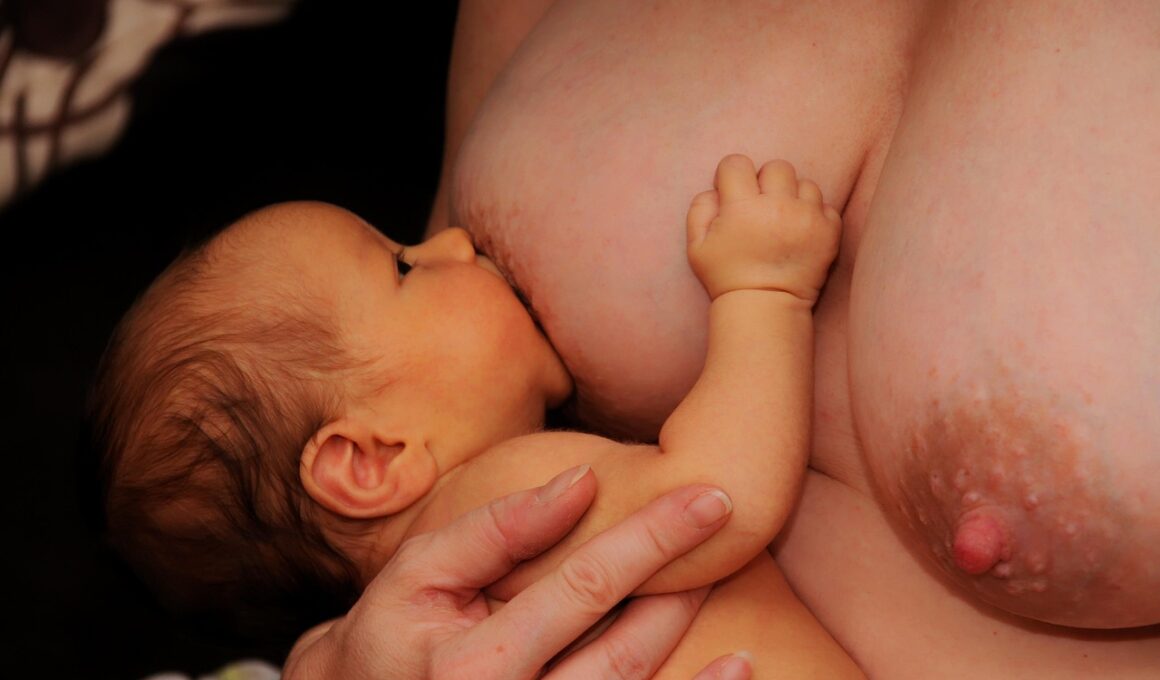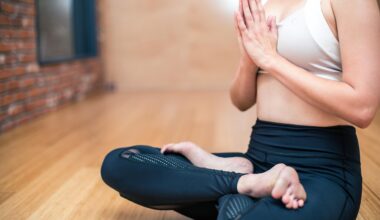The Benefits of Postpartum Workouts for Breastfeeding Mothers
Postpartum workouts play a pivotal role in enhancing overall health for breastfeeding mothers. Engaging in safe and effective exercises can lead to numerous physical and mental benefits. First, workouts help in weight management, crucial for mothers aiming to return to pre-pregnancy body size. Second, regular physical activity enhances mood through the release of endorphins, which helps combat postpartum depression. This emotional uplift is significant during a demanding phase like breastfeeding. Additionally, physical strength is maintained or improved, benefiting both motherhood and self-care routines. Moreover, engaging in postpartum specific exercises can increase energy levels. Many mothers report feeling more capable and energized during their day-to-day activities. This energy boost supports the often demanding needs of a newborn. Lastly, postpartum workouts can improve mental clarity. Regular exercise stimulates brain function and keeps mothers alert, making it easier to focus on tasks at hand. Incorporating safe workouts into daily routines ensures mothers feel complete physically and mentally. The crucial element here is ensuring workouts adapt to individual fitness levels to avoid injury. Hence, consultation with a healthcare provider before starting a routine is strongly encouraged. Embrace the journey to fitness alongside motherhood!
Strengthening Core and Pelvic Floor
Postpartum workouts specifically target the restoration of the core and pelvic floor, essential areas for mothers after childbirth. A strong core aids in daily functions and reduces back pain, a common issue postpartum families face. When these muscles are healthy, strength and stability improve, creating a solid foundation for future fitness endeavors. This focus on core and pelvic floor is especially crucial for breastfeeding mothers. They often hold their babies in positions that exert pressure on these areas. Additionally, improved pelvic floor strength can lead to enhanced bladder control, a common concern during and after pregnancy. Such targeted exercises not only enhance physical well-being but also contribute to improved posture. Enhanced posture plays a crucial role in overall body mechanics, which is particularly important for breastfeeding mothers who navigate long hours of feeding and holding their infants. Postpartum specific workouts incorporate exercises that promote the natural contraction of the pelvic floor muscles, such as Kegel exercises and gentle core work. Gradually integrating strength training helps in avoiding injury while also facilitating progress. Regular practice can lead to impressive results, making mothers feel confident in their bodies again while managing their newborns. Start slow and listen to your body!
Furthermore, the emotional benefits of postpartum workouts cannot be understated. Many mothers experience feelings of isolation and anxiety after childbirth. Participating in group fitness classes or mom-and-baby workouts provides social interaction and emotional support. Such activities foster connections with others going through similar stages in life, creating a community of encouragement. This sense of belonging reduces feelings of loneliness and stress. Connecting with like-minded individuals over shared experiences bolsters motivation and accountability in fitness goals. Participating in physical activities together can also strengthen relationships and bonds with fellow mothers. Those seeking interaction may find online or local community classes ideal. Offering flexibility, virtual classes can fit any schedule, encouraging participation even with busy lives. Moreover, these workout options can be adapted to accommodate infants, allowing mothers to involve their babies, creating unforgettable experiences. Physical exertion can also translate into improved self-esteem. As mothers engage in exercise and healthful habits, they find a renewed appreciation for their bodies. Positive self-image fosters confidence. Gradually, these emotional benefits combine with the physical advantages. A balance of these elements creates a healthier, happier lifestyle for mothers and their children. Motherhood need not impede on fitness goals!
Encouraging Long-Term Fitness Habits
Establishing a routine of postpartum workouts paves the way for long-term fitness habits. This transition is vital for mothers not just during the infant phases but through various life stages. The early experiences create foundational health behaviors that influence future family wellness. When mothers prioritize physical activity, they serve as role models for healthier lifestyle choices for their children. Children notice their parent’s approach to health and fitness and may adopt similar habits in their lives. Encouraging children to engage in outdoor activities and sports is essential as they observe their mothers maintaining fitness routines. The focus on health can inspire healthier family activities, like hiking or biking. Therefore, it’s crucial that moms prioritize their fitness. As they cultivate these habits, they inadvertently promote the importance of living actively and making fitness a priority as a family. With the right approach, postpartum workouts help create an environment that values health. This lifestyle translates to overall well-being throughout life. The study of family health behaviors shows that happy, active parents often lead to healthier children in the long run. Make fitness a family affair! Together, these simple practices can enhance the quality of life for everyone.
Breastfeeding itself greatly benefits from regular exercise. Engaging in suitable workouts can help maintain adequate milk supply for breastfeeding mothers. Research indicates that physical activity does not negatively impact milk production. In fact, moderate exercise has been shown to promote better nutritional quality in breast milk, consequently benefiting the baby. Fitness can also improve circulation, which is vital during the breastfeeding phase. Enhanced circulation helps in delivering nutrients effectively through milk. Additionally, increased fitness levels can contribute to overall well-being, ensuring mothers remain healthy to care for their infants. This synergy between physical activity and breastfeeding cultivates a positive feedback loop. When mothers feel physically good, they are more likely to continue breastfeeding longer, which is beneficial for their babies. Incorporating activities such as walking, swimming, or postpartum yoga proves effective in balancing movement and lactation. Prioritizing hydration while exercising further supports milk production. As mothers actively engage in physical fitness, it fosters self-care routines that significantly benefit both mother and child. Ensuring that postpartum workouts are enjoyable is essential for sustainability. Prioritize consistent movement, in whichever format brings joy. This happiness transforms the experience and enhances dedication for mothers.
Practical Tips for Starting Workouts
To initiate a postpartum workout routine, a few practical tips can make a significant difference. First, consult with a healthcare provider to get personalized recommendations based on specific health situations. This step guarantees safety while returning to physical activity. Next, focus on setting manageable goals. Setting small, attainable targets encourages motivation and provides milestones to celebrate. Additionally, consider scheduling workouts at convenient times that fit into daily routines. For instance, integrating fitness during nap times allows flexibility e. Furthermore, creating a structured workout plan that includes a mix of activities—like cardiovascular exercises, strength training, and flexibility work—ensures a balanced approach. Online platforms are brimming with suitable postpartum fitness resources, from workouts to pre-packaged plans. Many of these are led by certified trainers who understand mothers’ needs, making them more effective. Finding an accountability partner, such as another mother, oftentimes enhances adherence to a routine. Lastly, do not hesitate to adjust workouts as comfort levels evolve over time. It’s crucial to embrace the journey without push or rush. Gradually building intensity helps mothers adapt to changes in their bodies, leading to positive fitness experiences.
In conclusion, the importance of postpartum workouts for breastfeeding mothers transcends the physical realm, encompassing emotional, social, and mental benefits. Embracing a balanced fitness journey fosters wellness for mothers and their babies. As mothers acknowledge the correlation between self-care and parental responsibilities, they set themselves up for success in fitness and well-being. Physical activity encourages improved mood and decreased stress levels while enabling mothers to reclaim their bodies. The connection between exercise and breastfeeding exemplifies a holistic approach to motherhood. As mothers engage in workout routines, they bond with others, forming an essential support network for navigating this demanding journey. Furthermore, as fitness becomes a priority, families witness changes that promote healthier lifestyles. Instituting these habits now sets the stage for generations to come, leading to stronger family relations and healthier cognitive growth for children. Realizing that every bit of movement contributes to long-term wellness is key. The focus on hydration and nutrition also underpins the journey, ensuring mothers feel their best throughout. The pathway may be challenging, but the rewards of prioritizing postpartum fitness far outweigh the efforts involved. So, embrace the journey, celebrate progress, and acknowledge each step taken during this transformative period.
Plan a diverse routine that excites and transforms the postpartum period into a vibrant health experience. Regular, gradual adjustments to fitness will adapt to personal needs, ensuring longevity and a joyful approach to motherhood!


